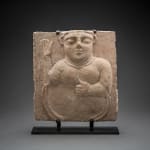Sabean Stone Stela Depicting a Woman, 200 BCE - 200 CE
Stone
20.3 x 20.3 cm
8 x 8 in
8 x 8 in
LO.555
The ancient Kingdom of Saba was located in modern day Yemen. It is most famous as the residing place of the Queen of Sheba who visited King Solomon in the...
The ancient Kingdom of Saba was located in modern day Yemen. It is most famous as the residing place of the Queen of Sheba who visited King Solomon in the tenth century BC. Situated on the crossroads between Asia and Africa, it derived immense wealth from its trading connections. Frankincense and myrrh were its most important products, as the resins for these spices only grow in eastern Yemen, southern Oman and parts of Somalia. These precious commodities were burnt on altars across the Near East and the Mediterranean.
This stunning sculpture was used as a grave-marker and belongs to a distinctive group of South Arabian dedication plaques. It depicts the bust of a woman in high relief against a rectangular slab. Other examples of this type have inscriptions along the base which often name the deceased and/or the god to whom they had a special devotion. The Sabeans were polytheistic until the late 4th century AD. It is likely that this piece also had a dedication which is now lost. The woman is shown in a characteristic pose with her right arm raised and her left held across the chest just beneath her ample breasts. Other surviving pieces depict the woman holding a sheath of wheat in her left hand, a symbol associated with fertility. It is likely that the large breasts perform a similar function here. She wears a high-neck short-sleeve tunic. Only the hairline is depicted along the top edge. The hair may have been lost or it could have been added separately in plaster, which was common on other funerary sculpture from Yemen. The eyes and eyebrows may have originally been highlighted with red or black pigment.
Although the identity of the sitter has been lost, the decision to commission a stone memorial is indicative of her wealth and status. The sculpture is a testament to the Sabaeans belief in an afterlife as well as the need to venerate one’s ancestors.
For a similar example see Simpson ed., 'Queen of Sheba: Treasures From Ancient Yemen,' (2002), pp. 200-201, fig. 282. (AM)
This stunning sculpture was used as a grave-marker and belongs to a distinctive group of South Arabian dedication plaques. It depicts the bust of a woman in high relief against a rectangular slab. Other examples of this type have inscriptions along the base which often name the deceased and/or the god to whom they had a special devotion. The Sabeans were polytheistic until the late 4th century AD. It is likely that this piece also had a dedication which is now lost. The woman is shown in a characteristic pose with her right arm raised and her left held across the chest just beneath her ample breasts. Other surviving pieces depict the woman holding a sheath of wheat in her left hand, a symbol associated with fertility. It is likely that the large breasts perform a similar function here. She wears a high-neck short-sleeve tunic. Only the hairline is depicted along the top edge. The hair may have been lost or it could have been added separately in plaster, which was common on other funerary sculpture from Yemen. The eyes and eyebrows may have originally been highlighted with red or black pigment.
Although the identity of the sitter has been lost, the decision to commission a stone memorial is indicative of her wealth and status. The sculpture is a testament to the Sabaeans belief in an afterlife as well as the need to venerate one’s ancestors.
For a similar example see Simpson ed., 'Queen of Sheba: Treasures From Ancient Yemen,' (2002), pp. 200-201, fig. 282. (AM)



